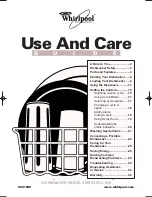
8
OPERATING YOUR APPLIANCE
OPERATING YOUR COOKTOP
Any burner can be turned on by pushing the control knob down and turning it clockwise or counter-
clockwise to the desired setting. To adjust the setting, turn the knob without pressing down. The burner is
turned off by turning the control knob clockwise or counter-clockwise to "0FF".
OPERATING INDICATORS
When a burner is turned on the corresponding operating indicator will light up regardless of the setting.
RESIDUAL HEAT INDICATOR
The residual heat indicator will light up when some part of the glass ceramic cooktop is too hot to touch or
place articles upon. Do not place articles other than cookware on the cooking surface while this light is
glowing.
COOKWARE SELECTION
The cooking surface
Your ceramic cooktop is made of an extremely hard and durable material. The surface is scratch resistant,
not scratch proof. Avoid using cookware with ridged bottoms. Ridged pots with dirty or chipped enamel
bottoms may scratch the cooktop if they are pulled across the ceramic surface.
Make sure the cooktop and pot bottoms are clean before cooking. Certain items, particularly sugar grains
or crystallized liquids such as molasses or syrups are actually harder than ceramic and can scratch the
surface if they are not cleaned off immediately. However, small or light scratches will not affect the safety
or performance of the cooktop.
Pots and pans
Special cookware is not required, but as is true with all types of cooking appliances, the better the
cookware, the better the performance.
Following these tips will allow you to make the most of your ceramic cooktop.
•
For the most even and energy efficient cooking, the diameter of the pots should match the diameter
of the burners as closely as possible.
•
Use cookware with thick, flat, smooth bottoms. Slightly concave bottoms will also work adequately.
Pans with convex bottoms will not cook well.
•
Using a lid while cooking will minimize the loss of heat and decrease the cooking time.
•
Copper bottom and aluminum pans may leave a residue on the cooktop in the form of metallic lines.
This is normal. These lines can be removed using a non-abrasive ceramic cooktop cleaner or a
shielded scraper blade.
•
Cast iron, glass or stoneware should not be used because they have poor heat transfer and may
scratch the surface.
CAUTION:
Be sure to clean the cooktop after each use. Each time the residue is allowed to melt it
becomes harder to remove and may mar the appearance of the cooktop. Let the cooktop cool before
cleaning.
WARNING
Do not touch or lay any heat sensitive objects on the cooktop while the operating/residual
heat indicator is still on. Danger of burns and fire hazard!






























